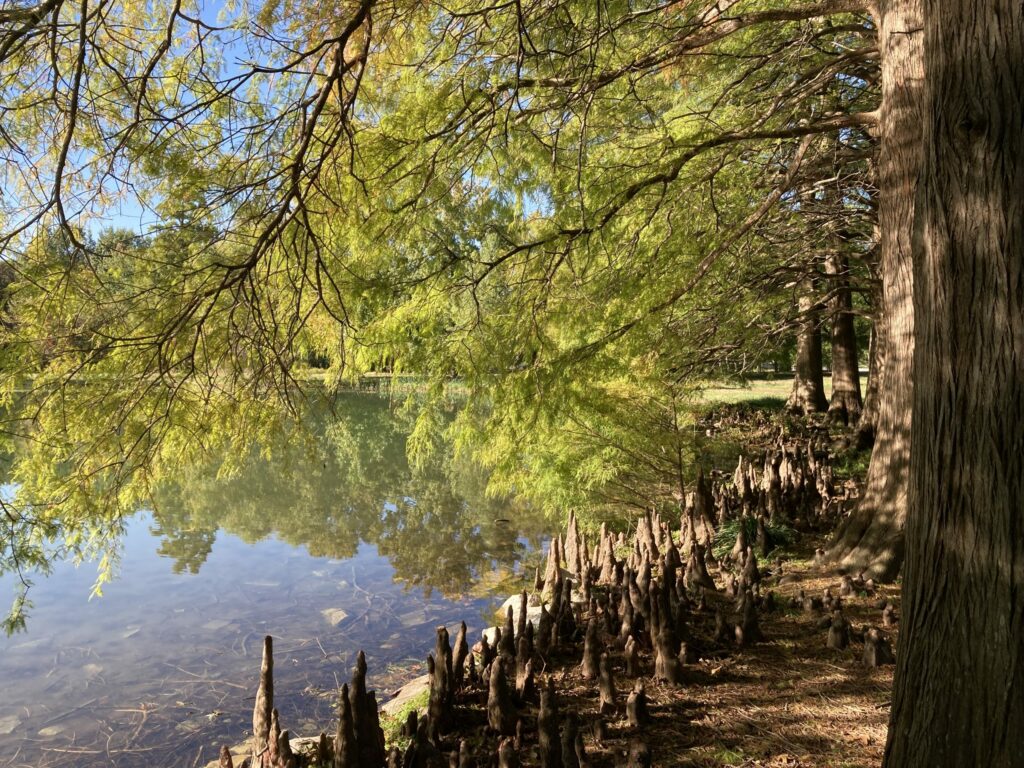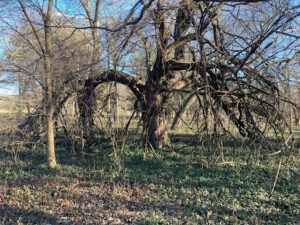By: Mark Halpin, Forestry Manager
Bald Cypress, Taxodium distichum, always seems to look best in groves. Stepping into one of these groupings in the late fall or winter, when the trees have rolled out their red carpet of soft, fern-like needles on the ground for you, is like entering into nature’s finest cathedral. The aromatic oils wafting from the leaves and fallen cones fill the air like a fine incense. Your eyes can trace the thin striping of the red bark from the wide, buttressed trunk with its deep furrows, all the way up into the heavens where the treetops gently sway like breathing spires. It is easy to see why this tree has been planted widely the whole world over, and is a perennial favorite of arborists, foresters, horticulturists, and just general tree-lovers, wherever it grows.
This is the longest-lived tree species east of the Rocky Mountains, with a 2,600 years old specimen on record in North Carolina (to the west, Bristelcone Pine edges it out by a couple thousand years and the Giant Sequoia – a close relative of Taxodium – by a few hundred). Bald Cypress is an incredibly durable tree: the wood is highly resistant to decay, and ancient logs salvaged from swamps are still viable for woodworking. The tree is resistant to pests and diseases of all types, its tissue exceedingly supple and able to withstand the hurricane winds so common in the southern portion of its range, as well as ice loads further to the north. Its growth habit magnifies this strength, forming a central leader with evenly spaced, not-too-large lateral branches. Reaching 120 feet, it is often the tallest tree in an area measured from the ground (or water), but its habit of dwelling in swamps and bottomlands further protects it from damage. With a modest spread seldom exceeding 30 feet, it is paradoxically a huge tree that can fit into relatively tight areas in a landscape, and can be planted in tight groupings without “cramping its style.”
Bald Cypress is “bald” because it drops its needles; it is a “deciduous conifer”. We often use the terms “evergreen” and “conifer” interchangeably, but this plant, along with evergreen angiosperms like many Hollies and the Southern Magnolia, remind us that this isn’t correct. Deciduous conifers are uncommon, but we have three in our region that perform admirably: Bald Cypress, Pond Cypress (Taxodium ascendens, a “sister species”) and Dawn Redwood (Metasequoia glyptostroboides, quite a mouthful), a distant cousin from China.
The needles of deciduous conifers tend to be much softer and less prickly than their evergreen relatives, making them much more pleasant to work around. If you have one in your landscape (and this applies to all conifers), do yourself and the tree a favor and rake them into a pile around the tree’s root zone; they make excellent mulch and acidify the soil, which is just what these trees want. It is wonderfully fragrant work.
Bald Cypress will grow quickly with adequate moisture (up to 2 feet per year), but is surprisingly tolerant of dry conditions and can be an excellent street tree. Its famous (and often-cursed) “knees” (pneumatophores, in scientific jargon) tend not to form in such dry conditions. Its soft foliage, lovely fragrance, long life and ease of care have made it a favorite choice in parks. It seldom requires any pruning other than removal of lower limbs for clearance. It’s one of those trees that’s almost too good to be true – long lived, fast growing, problem free, gorgeous and fragrant. So pretty, it’s worth putting a canoe into an alligator-infested swamp to gaze at it in its natural habitat.
Pictured: Pneumatophores form in abundance by the water’s edge. They most likely serve to stabilize trees in wet soils, but their function is still poorly understood.




